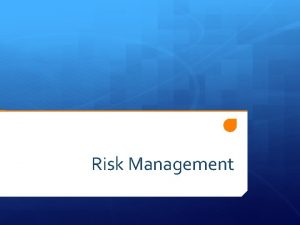Risk Management 1 What is Risk Risks are











- Slides: 11

Risk Management 1

What is Risk? • Risks are potential problems that may affect successful completion of a software project. • Risks involve uncertainty and potential losses. • Risk analysis and management are intended to help a software team understand manage uncertainty during the development process. 2

Risk Strategies • Reactive strategies – very common, also known as fire fighting – project team sets resources aside to deal with problems – team does nothing until a risk becomes a problem • Proactive strategies – risk management begins long before technical work starts, risks are identified and prioritized by importance – team builds a plan to avoid risks if they can or to minimize risks if they turn into problems 3

Software Risks - 1 • Project risks – threaten the project plan • Technical risks – threaten product quality and the timeliness of the schedule • Business risks – threaten the viability of the software to be built (market risks, strategic risks, management risks, budget risks) 4

Software Risks - 2 • Known risks – predictable from careful evaluation of current project plan and those extrapolated from past project experience • Unknown risks – some problems will simply occur without warning 5

Risk Analysis • Risk identification • Risk projection – impact of risks/likelihood of risk actually happening • Risk assessment – what will change if risk becomes problem • Risk management 6

Risk Identification • Product-specific risks – the project plan and software statement of scope are examined to identify any special characteristics of the product that may threaten the project plan • Generic risks – are potential threats to every software product • • product size customer characteristics development environment technology to be built 7

Risk Projection • The risk drivers affecting each risk component are – classified according to their impact category – potential consequences of each undetected software fault or unachieved project outcome are described 8

Risk Impact • Risk components – – performance cost support schedule • Risk impact – – negligible marginal critical catastrophic 9

Risk Estimation 1. Establish a scale indicating perceived likelihood of risk occurring 2. Determine consequences. 3. Estimate impact of consequences on project (for each risk). 4. Note overall accuracy of risk projection (to avoid misunderstandings). 10

Risks Category Probability Impact RMMM Estimated size of project in LOC or FP PS 80% 2 ** Lack of needed specialization increases defects and reworks ST 50% 2 ** Unfamiliar areas of the product take more time than expected to design and implement DE 50% 2 ** Does the environment make use of a database DE 35% 3 Components developed separately cannot be integrated easily, requiring redesign DE 25% 3 Development of the wrong software functions requires redesign and implementation DE 25% 3 Development of extra software functions that are not needed DE 20% 3 Strict requirements for compatibility with existing system require more testing, design, and implementation than expected DE 20% 3 Operation in unfamiliar software environment causes unforeseen problems EV 25% 4 Team members do not work well together ST 20% 4 Key personnel are available only part-time ST 20% 4 11
 Insidan region jh
Insidan region jh The biggest risk is not taking any risk
The biggest risk is not taking any risk Chapter 1 lesson 3 health risks and your behavior
Chapter 1 lesson 3 health risks and your behavior Cash management risks
Cash management risks Credit risk market risk operational risk
Credit risk market risk operational risk Key risk indicators template
Key risk indicators template Risk map
Risk map Scr limited
Scr limited Risks of e procurement
Risks of e procurement Risks of e procurement
Risks of e procurement Instant messaging security issues
Instant messaging security issues Civil engineering insurance policies
Civil engineering insurance policies





















